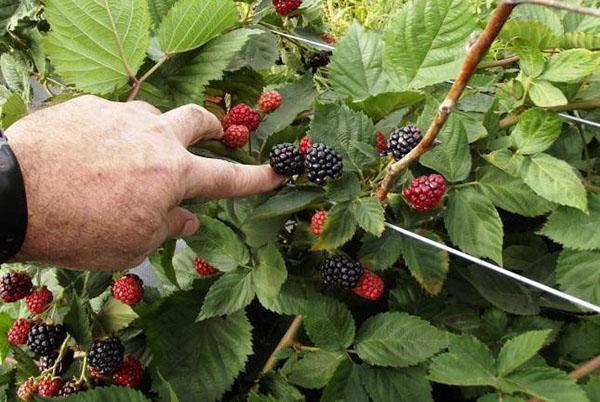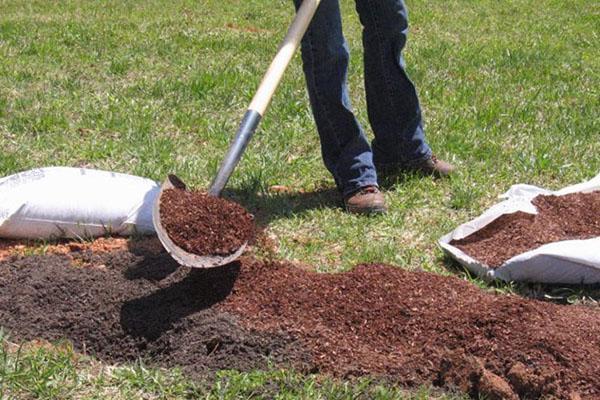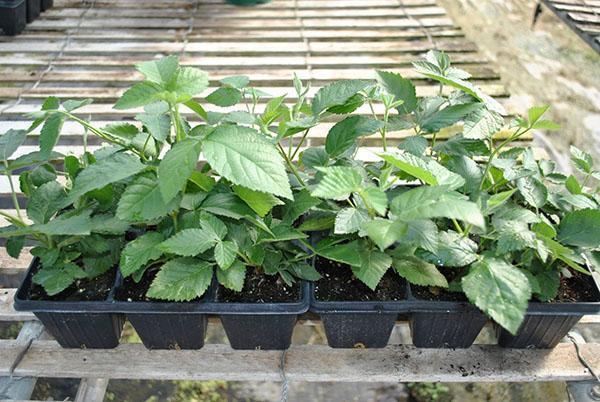Planting and caring for garden blackberries
 The blackberry that migrated to the garden from the forest edge, while remaining a generous and flexible culture, has become even sweeter, larger and more aromatic. However, no matter how unpretentious the blackberry is, planting and caring for its cultivated varieties require the knowledge and attention of the summer resident.
The blackberry that migrated to the garden from the forest edge, while remaining a generous and flexible culture, has become even sweeter, larger and more aromatic. However, no matter how unpretentious the blackberry is, planting and caring for its cultivated varieties require the knowledge and attention of the summer resident.
Wild varieties of this perennial shrub often have a creeping shape. Thanks to their long, thorny shoots, they form difficult-to-pass thickets on old clearings, forest edges or river banks. Cultivated plants and varieties obtained on their basis today can be both creeping and erect, resembling raspberries.
Features of planting and caring for garden blackberries depend on the structure of the bush, as well as on climatic conditions. How and when is it better to plant blackberries? What are the subtleties of growing this berry in different regions?
Planting blackberry seedlings in spring

If other fruit crops have two planting dates, autumn and spring, then blackberries are planted in spring, when the soil has warmed up well, and nothing interferes with the acclimatization of plants.
Since autumn, a sunny, wind-protected area with loose, well-drained soil is selected. For creeping varieties of blackberries, or as it is called "dewberries", a slope facing the south or west side, where the shoots and ovaries will be warmed by the sun, may be suitable. Erect varieties suffer less from the wind, but just like the plants adjacent to the ground, especially when planting and caring for blackberries in Siberia, they are not too winter hardy. Therefore, initially it is better to provide for the possibility of sheltering the berry, protecting it from frost.
Although blackberries are not very demanding on soil fertility, on soils rich in organic matter and mineral components, they bear fruit better and give larger berries.
 Therefore, planting pits and trenches are prepared in advance, filling the substrate per meter of area:
Therefore, planting pits and trenches are prepared in advance, filling the substrate per meter of area:
- 10 kg of humus or rotted manure;
- 25 grams of potassium salts;
- 15 grams superphosphate.
If necessary, soil loosening sand is added to the soil, as well as dolomite flour to bring the acidity level to the optimal pH 6. Since autumn, perennial and rhizome weeds are fought, plant residues are removed, under which pests and pathogens can winter.
In spring, when planting, blackberry seedlings of creeping varieties are placed at a distance of 2 - 2.5 meters from each other, leaving the same or more gaps between rows. For bushy plants with dense erect stems, a different scheme is used. An interval of 80–100 cm is made between the cuttings, and the row spacing should be up to 2 meters wide.
 Growth buds should be below the surface of the soil at a depth of 3–6 cm. To accelerate the survival rate and simplify the care of the blackberry, it is important to spread the roots of the seedlings when planting, and sprinkle them with water. Then the soil mulch peat, humus, grass cuttings, straw or other material.
Growth buds should be below the surface of the soil at a depth of 3–6 cm. To accelerate the survival rate and simplify the care of the blackberry, it is important to spread the roots of the seedlings when planting, and sprinkle them with water. Then the soil mulch peat, humus, grass cuttings, straw or other material.
If the seedlings are too long, they should be shortened to 20 cm. Fruit branches that weaken the young plant should be pruned. This measure will allow the plant not to waste extra energy, quickly acclimatize and start growing.
 Further care for blackberries in the spring includes watering the plantings, carefully loosening the soil to a depth of no more than 10–12 cm and weeding.In the first year, the berry garden will not yield a harvest, but all the work will pay off when two-year-old fruiting shoots appear.
Further care for blackberries in the spring includes watering the plantings, carefully loosening the soil to a depth of no more than 10–12 cm and weeding.In the first year, the berry garden will not yield a harvest, but all the work will pay off when two-year-old fruiting shoots appear.
Outdoor care for blackberries
In addition to irrigation, fertilizing and weeding, which are mandatory for all green plants, care when growing blackberries includes pruning and supporting bushes.
If planting blackberries in the garden consists of creeping plants, support will be required for them to bear fruit and grow actively. Trellis for berry bushes are made of strong posts with several rows of wire stretched between them. The whips are tied to the upper level, which are already gaining color and will bear fruit this year. The stems of the new growth or replacement shoots are directed to the trellis below so that all parts of the plant are ordered, receive light and air.
 When growing blackberries in Siberia and in other regions difficult for fruit horticulture, the lashes are directed along a wire radiating from the center of the bush and fixed on strong, but not high pillars. This allows you to "hide" the berry from the cold wind and even cover it with non-woven material until the threat of frost has passed.
When growing blackberries in Siberia and in other regions difficult for fruit horticulture, the lashes are directed along a wire radiating from the center of the bush and fixed on strong, but not high pillars. This allows you to "hide" the berry from the cold wind and even cover it with non-woven material until the threat of frost has passed.
Erect blackberry bushes are easier to care for. Their strong stems do not need additional support, but to obtain a harvest, young shoots must be pinched. Depending on the variety and region of cultivation, they are cut at a height of 100 to 180 cm, forcing to bush. The lateral processes are also cut off when they reach 50 cm in length.
 Despite the seeming ease of care, when planting blackberries in the Urals and to the east, summer residents are faced with the fact that it is very difficult to shelter such plants for the winter. To deal with bush:
Despite the seeming ease of care, when planting blackberries in the Urals and to the east, summer residents are faced with the fact that it is very difficult to shelter such plants for the winter. To deal with bush:
- in advance, a load is suspended on the shoots, "teaching" them to bend to the ground;
- they dig in the bush a little and forcibly lay it down until spring.
In this form, the plant can be covered with any available artificial or natural material. The culture very rarely undergoes heating, therefore, when planting blackberries in the Leningrad Region and caring for them, you should not be afraid of damage to the stems under a layer of spruce branches or straw. But the resulting hard crust or the absence of snow in cold weather can cause significant harm to plantings.
Non-woven fabric, which was used in cold weather to protect from the cold, will help to save berries from burns in summer and keep their sweet, bitter-free taste.
Watering and feeding garden blackberries after planting
 Due to the similarity with raspberries the parts apply the same care techniques to the blackberry. However, cultures have significant differences. For example, the root system of garden blackberries lies deeper, so the bushes are less affected by drought and in favorable climatic conditions can bear fruit even without watering. But it is unlikely that, letting the care of the bush take its course, you can get large berries of excellent taste.
Due to the similarity with raspberries the parts apply the same care techniques to the blackberry. However, cultures have significant differences. For example, the root system of garden blackberries lies deeper, so the bushes are less affected by drought and in favorable climatic conditions can bear fruit even without watering. But it is unlikely that, letting the care of the bush take its course, you can get large berries of excellent taste.
Blackberries, especially young ones, need to be watered throughout the growing season. Most of all, the plant needs water during the formation of replacement shoots and filling berries.
Growing blackberries is impossible without top dressing. Introduction nitrogen fertilizers at the rate of 20 grams per square meter and organic additives 4 kg each is included in the care of blackberries in spring. At the same time or in the first half of summer, the berry is fertilized with potassium, 40 grams, phosphorus, 50 grams per meter. Mineral additives are used if manure or humus is not used. Granular fertilizers are embedded in moist soil, and the introduction of liquid formulations is combined with irrigation.
 Mulch will help to preserve moisture and protect the soil from crusting. It will save the summer resident's silt by replacing several weeding and loosening of the soil.
Mulch will help to preserve moisture and protect the soil from crusting. It will save the summer resident's silt by replacing several weeding and loosening of the soil.
Pruning blackberries when planting and nursing in the open field
 Pruning of blackberry bushes is carried out in several stages, and its technology varies depending on the cultivated variety. When caring for blackberries in the spring, it is imperative to remove dead stems, shorten or cut stems affected by frost.
Pruning of blackberry bushes is carried out in several stages, and its technology varies depending on the cultivated variety. When caring for blackberries in the spring, it is imperative to remove dead stems, shorten or cut stems affected by frost.
Young, not yet fruiting blackberry bushes are pruned:
- in May, shortening the tops of the shoots by a few centimeters;
- in the middle of summer, removing the tops of lateral shoots that have reached a length of 40–50 cm;
- in summer, all weak shoots are under the root, except for 5-10 of the strongest, formed stems, which will give the first harvest next year.
Before sheltering for the winter, you need to continue to remove the newly emerging root shoots. They will not have time to ripen, but only take away the strength necessary for wintering from the bush.
 In the northern regions, for example, in Siberia, Bashkiria, in the Urals and in the North-West of the country, when planting and caring for blackberries in the open field, it is pruning that helps a plant with a long growing season to form an ovary and give a crop.
In the northern regions, for example, in Siberia, Bashkiria, in the Urals and in the North-West of the country, when planting and caring for blackberries in the open field, it is pruning that helps a plant with a long growing season to form an ovary and give a crop.
For this, fruit-bearing shoots in upright plants are cut over the first healthy bud, and in creeping varieties, only 3-4 buds are left. Be sure to carry out sanitary pruning of bushes and constantly remove root shoots. Fruit-bearing shoots are removed from the harvest field, and no more than 4 erect and 3 creeping stems are left for the winter to replace. Since September, shoots begin to bend down, which, with the arrival of winter, not only insulate, but also cover with snow.